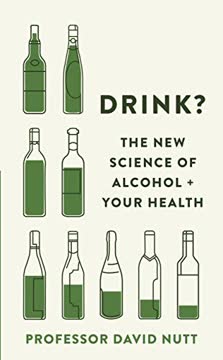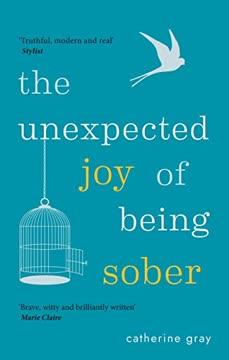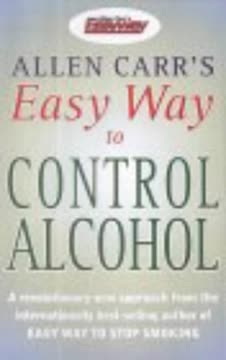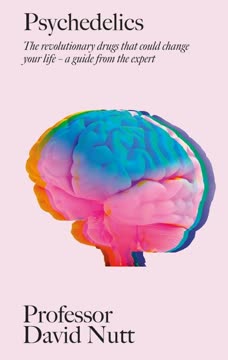Key Takeaways
1. Alcohol's Effects: From Sip to Hangover
As you can see, the brain is an incredibly evolved and finely balanced machine. And then you add in alcohol and that balance dissolves like the sugar cube in a hot cup of tea – or rather, a hot toddy.
The Brain's Intricate Dance. Alcohol's journey through the body begins with the first sip, rapidly absorbed into the bloodstream and making its way to the brain. Here, it disrupts the delicate balance of neurotransmitters, the chemical messengers that govern our thoughts, emotions, and behaviors. Alcohol's promiscuous nature allows it to interact with various receptors, leading to a cascade of effects, from relaxation and euphoria to impaired judgment and coordination.
Neurotransmitter Chaos. Alcohol primarily affects GABA, the brain's calming agent, and glutamate, its excitatory counterpart. By enhancing GABA and blocking glutamate, alcohol initially induces relaxation and reduces anxiety. However, this imbalance can lead to a rebound effect, causing anxiety, restlessness, and sleep disturbances as the brain attempts to restore equilibrium. Serotonin, dopamine, and endorphins are also influenced, contributing to mood changes, feelings of reward, and even addiction.
The Morning After Withdrawal. The dreaded hangover is essentially a mini-withdrawal, characterized by a cocktail of unpleasant symptoms, including headache, nausea, fatigue, and cognitive impairment. These effects stem from a combination of factors, including acetaldehyde toxicity, neurotransmitter imbalances, inflammation, and mitochondrial dysfunction. While various "cures" exist, the most effective prevention remains moderation or abstinence.
2. The Murky Waters of "Safe" Drinking Levels
The reality of alcohol is this: drinking raises your risk of health harms.
Risk vs. Reward. Determining a "safe" level of alcohol consumption is a complex equation, balancing potential health risks with perceived social benefits. While some studies have suggested a protective effect of moderate drinking on cardiovascular health, emerging evidence increasingly points to the absence of a truly safe level, particularly concerning cancer risk. The UK's recommended limit of 14 units per week aims to minimize risk, but individual factors and personal risk tolerance should guide decision-making.
Microlives and Mortality. The concept of "microlives" provides a stark illustration of alcohol's impact on life expectancy. Each microlife represents 30 minutes of life lost, with seven units of alcohol per day costing one microlife. The more you drink, the worse it gets because of the exponential nature of the health harms of alcohol. Exceeding recommended limits significantly shortens life expectancy, underscoring the importance of mindful consumption.
Individual Factors. The impact of alcohol varies depending on age, sex, genetics, and overall health. Women, for example, tend to experience higher blood alcohol levels than men due to differences in body composition. Genetic predispositions can also influence alcohol metabolism and susceptibility to addiction. Ultimately, informed choices based on individual circumstances are paramount.
3. Alcohol's Role in Accidents and Aggression
It’s a lethal combination: alcohol helps you shed your fear but also your judgement.
Accidents Happen. Alcohol impairs judgment, coordination, and reaction time, increasing the risk of accidents and injuries. From falls and burns to drownings and traffic collisions, alcohol-related accidents claim countless lives each year. The combination of reduced inhibitions and impaired physical abilities creates a dangerous cocktail, leading to impulsive decisions and tragic consequences.
Drink Driving Dangers. Drink driving remains a significant threat, despite decades of public awareness campaigns. Even small amounts of alcohol can impair driving ability, and the risk of accidents increases exponentially with higher blood alcohol concentrations. Lowering the drink-drive limit, implementing random breath testing, and utilizing in-car breathalyzers are potential strategies for reducing alcohol-related road fatalities.
Fueling Violence. Alcohol is a well-established contributor to violence, both within and outside the family. It disinhibits aggression, impairs judgment, and increases the likelihood of misinterpreting social cues. Domestic violence, sexual assault, and public brawls are frequently linked to alcohol consumption, highlighting its role in escalating conflict and causing harm to individuals and communities.
4. Mental Health: A Delicate Balance Disrupted by Alcohol
There’s no denying that alcohol makes you feel good – in the short term.
The Illusion of Relief. While alcohol may provide temporary relief from anxiety and depression, it ultimately disrupts the delicate balance of brain chemistry, exacerbating mental health issues in the long run. The initial calming effect is followed by a rebound effect, leading to increased anxiety, irritability, and sleep disturbances. This cycle can contribute to a vicious circle of self-medication and dependence.
Co-occurring Conditions. Alcoholism frequently co-occurs with other mental health conditions, such as anxiety disorders, depression, PTSD, and bipolar disorder. In these cases, it can be challenging to determine which condition came first, as alcohol can both trigger and worsen existing mental health problems. Effective treatment requires addressing both the alcohol use and the underlying mental health issues.
Suicide Risk. Alcohol intoxication is strongly associated with suicide attempts, as it impairs judgment, increases impulsivity, and exacerbates feelings of despair. The risk is particularly high during periods of withdrawal, when individuals may experience intense anxiety, depression, and hopelessness. Preventing suicide requires addressing both alcohol use and underlying mental health conditions, as well as providing support and resources for those at risk.
5. Hormonal Havoc: Alcohol's Impact on Fertility and More
Alcohol is a poison, and the liver is in charge of breaking down poisons, as well as other drugs and chemicals.
Endocrine System Disruption. Alcohol disrupts the delicate balance of the endocrine system, a network of glands and hormones that regulate various bodily functions. This disruption can lead to a cascade of effects, impacting reproductive health, stress response, and overall well-being. Chronic alcohol use can alter hormone levels, leading to fertility problems, sexual dysfunction, and other health issues.
Reproductive Repercussions. Alcohol consumption can negatively impact both male and female fertility. In men, it can lower testosterone levels, impair sperm production, and increase the risk of impotence. In women, it can disrupt menstrual cycles, interfere with ovulation, and increase the risk of miscarriage. Couples trying to conceive are advised to limit or abstain from alcohol.
Pregnancy Peril. Drinking during pregnancy poses significant risks to the developing fetus, potentially leading to fetal alcohol spectrum disorders (FASD). FASD encompasses a range of physical, mental, and behavioral problems, including facial abnormalities, developmental delays, and learning disabilities. No amount of alcohol is considered safe during pregnancy, and abstinence is strongly recommended.
6. Quality of Life: How Alcohol Steals Your Shine
What I would like to help you do is make you think about your drinking.
Beyond Health Harms. The impact of alcohol extends beyond physical and mental health, affecting various aspects of quality of life, including sleep, appearance, work performance, and relationships. Even moderate drinking can disrupt sleep patterns, leading to fatigue, irritability, and impaired cognitive function. Alcohol's dehydrating effects can also take a toll on the skin, contributing to premature aging and other skin problems.
Workplace Woes. Alcohol impairs concentration, memory, and judgment, negatively impacting work performance. Hangovers can lead to absenteeism, reduced productivity, and increased risk of accidents. The social pressure to drink at work events can also create discomfort and anxiety for those who prefer to abstain.
Fitness Fumbles. Alcohol interferes with muscle recovery, reduces strength, and disrupts hormone levels, hindering fitness goals. It also adds empty calories to the diet, contributing to weight gain and hindering efforts to maintain a healthy body composition. While some may enjoy a post-workout beer, moderation is key to avoid undermining fitness progress.
7. Addiction's Grip: Recognizing and Confronting the Problem
I drank to drown my sorrows, but the dammed things learned how to swim.
More Than Just a Habit. Addiction is a complex brain disorder characterized by compulsive drug-seeking behavior despite negative consequences. It's not simply a matter of willpower or moral failing, but rather a result of changes in brain circuitry that make it difficult to control impulses and resist cravings. Recognizing the signs of addiction is the first step towards seeking help.
Warning Signs. Key indicators of a potential alcohol problem include drinking more than intended, experiencing withdrawal symptoms, neglecting responsibilities, and continuing to drink despite negative consequences. Secrecy, defensiveness, and denial are also common signs of a developing problem. Seeking professional help is crucial for accurate diagnosis and effective treatment.
Treatment Options. Treatment for alcohol addiction typically involves a combination of detoxification, medication, and psychological therapies. Detoxification helps manage withdrawal symptoms, while medications can reduce cravings and prevent relapse. Psychological therapies, such as cognitive-behavioral therapy (CBT) and motivational interviewing, help individuals develop coping skills and address underlying issues that contribute to their addiction.
8. The Social Facade: Unmasking Alcohol's True Nature
Sure, not all cultural references are positive.
The Double-Edged Sword. Alcohol holds a prominent place in many cultures, serving as a social lubricant, a celebratory symbol, and a source of relaxation. However, this widespread acceptance often masks its darker side, including its addictive potential, health risks, and contribution to social problems. Recognizing both the perceived benefits and the inherent dangers is crucial for fostering a more balanced and informed relationship with alcohol.
Marketing Manipulation. The alcohol industry employs sophisticated marketing techniques to promote its products, often targeting young people and associating drinking with desirable lifestyles. These campaigns can normalize excessive consumption and downplay the risks, contributing to a culture of heavy drinking. Counteracting these influences requires critical thinking and media literacy.
Passive Drinking. The harm from alcohol extends beyond the individual drinker, impacting families, friends, and communities. "Passive drinking" refers to the negative consequences experienced by those around the drinker, including violence, neglect, financial strain, and emotional distress. Addressing alcohol-related harm requires a societal approach that considers the well-being of all.
9. Strategies for Mindful Drinking: Taking Control
What I would like to help you do is make you think about your drinking.
Self-Awareness is Key. The first step towards mindful drinking is to gain a clear understanding of your own drinking habits, motivations, and triggers. Keeping a drink diary can help track consumption patterns, identify high-risk situations, and reveal underlying emotional factors that contribute to overdrinking. Honesty and self-reflection are essential for making lasting changes.
Setting Boundaries. Establishing clear limits on alcohol consumption is crucial for preventing overindulgence. This involves setting specific goals for the number of drinks per occasion, the frequency of drinking, and the types of beverages consumed. Sticking to these boundaries requires discipline and a willingness to prioritize long-term health over short-term gratification.
Behavioral Techniques. Various behavioral strategies can help reduce alcohol consumption, including pacing drinks, alternating with non-alcoholic beverages, avoiding triggers, and seeking support from friends and family. Finding alternative activities to replace drinking, such as exercise, hobbies, or social gatherings, can also help break the cycle of alcohol dependence.
10. Protecting the Young: Alcohol's Impact on Children
Alcohol should be a sensible conversation throughout your child’s life, not just when they ask to have their first party with alcohol.
Delaying Initiation. The Chief Medical Officer advises that children shouldn't drink at all before age 15, and those aged 15-17 should drink no more than once a week. Early alcohol exposure can interfere with brain development, hormone regulation, and bone growth, increasing the risk of long-term health problems and addiction. Delaying initiation is a key strategy for protecting young people from alcohol-related harm.
Open Communication. Honest and age-appropriate conversations about alcohol are essential for equipping children with the knowledge and skills to make informed decisions. Parents should discuss the risks of alcohol, the importance of moderation, and strategies for staying safe in social situations. Creating a supportive and non-judgmental environment can encourage open communication and reduce the likelihood of risky behavior.
Parental Role Modeling. Children learn by observing their parents' behavior, making it crucial for parents to model responsible drinking habits. This includes drinking in moderation, avoiding intoxication, and demonstrating healthy coping mechanisms for stress and emotions. By setting a positive example, parents can influence their children's attitudes and behaviors towards alcohol.
11. Societal Solutions: Reforming Our Relationship with Booze
What is important to know for the story of how alcohol works is that it – like other drugs – works at the level of this chemical connection.
Policy Interventions. Addressing alcohol-related harm requires a multi-faceted approach that includes policy interventions, public health campaigns, and community-based programs. Minimum unit pricing, restrictions on advertising, and increased access to treatment are potential strategies for reducing alcohol consumption and its associated harms. These measures should be implemented in conjunction with education and prevention efforts.
The French Paradox Revisited. France's success in reducing alcohol-related harm provides a valuable case study for other countries. By implementing comprehensive policies that target price, advertising, and availability, France has significantly reduced its rates of liver cirrhosis and other alcohol-related diseases. This demonstrates that effective alcohol control is possible, even in cultures with a long history of alcohol consumption.
A Call for Change. Reforming our relationship with alcohol requires a shift in societal attitudes and a willingness to prioritize public health over industry profits. This involves challenging the normalization of excessive drinking, promoting responsible consumption, and advocating for evidence-based policies that protect individuals and communities from alcohol-related harm. By working together, we can create a healthier and more sustainable future for all.
Last updated:
FAQ
What is "Drink?: The New Science of Alcohol and Your Health" by David J. Nutt about?
- Comprehensive science-based guide: The book explores the latest scientific understanding of alcohol’s effects on the body, brain, and society, written by leading neuropsychopharmacologist Professor David Nutt.
- Evidence-based approach: It challenges myths and misconceptions about alcohol, focusing on evidence rather than cultural or political biases.
- Practical advice: The book offers practical strategies for safer drinking, understanding addiction, and making informed choices about alcohol consumption.
- Societal and policy context: It also examines the broader societal, economic, and policy issues surrounding alcohol, including government guidelines and industry influence.
Why should I read "Drink?: The New Science of Alcohol and Your Health" by David J. Nutt?
- Authoritative expertise: David Nutt is a renowned expert in psychopharmacology, offering credible, research-backed insights.
- Clear, accessible language: The book is written for the general public, making complex science understandable and actionable.
- Personal and societal relevance: Whether you drink or not, the book addresses how alcohol impacts health, relationships, and society at large.
- Empowerment through knowledge: It helps readers make conscious, informed decisions about their drinking habits, rather than relying on cultural norms or misinformation.
What are the key takeaways from "Drink?: The New Science of Alcohol and Your Health"?
- Alcohol is a drug: The book emphasizes that alcohol is a powerful, addictive drug with significant health risks, often underestimated due to its legal and cultural status.
- No safe level: Scientific evidence shows that no level of alcohol consumption is completely safe, especially regarding cancer risk.
- Individual risk varies: Genetics, sex, age, and drinking patterns all influence how alcohol affects each person’s health and risk of addiction.
- Societal harms: Alcohol’s impact extends beyond the individual, causing significant harm to families, communities, and public health systems.
- Informed choices: The book provides tools and strategies for monitoring and reducing alcohol intake, advocating for conscious, mindful drinking.
How does "Drink?: The New Science of Alcohol and Your Health" by David J. Nutt explain the effects of alcohol on the body and brain?
- Neurotransmitter disruption: Alcohol affects multiple neurotransmitter systems (GABA, glutamate, dopamine, serotonin, endorphins), leading to relaxation, disinhibition, and, at higher doses, memory loss and unconsciousness.
- Rapid absorption: Alcohol is quickly absorbed into the bloodstream, affecting the brain within minutes and leading to a range of effects from mild relaxation to coma and death at high doses.
- Tolerance and dependence: Regular drinking leads to tolerance (needing more to feel the same effects) and can progress to physical and psychological dependence.
- Hangover science: Hangovers are a form of withdrawal, involving dehydration, inflammation, neurotransmitter imbalances, and toxic byproducts like acetaldehyde.
What health risks and diseases are associated with alcohol according to "Drink?: The New Science of Alcohol and Your Health"?
- Increased mortality: Alcohol is linked to over 200 diseases, including liver cirrhosis, cardiovascular disease, and multiple cancers (especially breast, mouth, and liver).
- Exponential risk: The more you drink, the greater the risk—harms increase exponentially, not linearly, with higher consumption.
- Brain damage and dementia: Alcohol is a leading preventable cause of dementia and brain damage, even at moderate levels.
- No health benefits: The book debunks the myth that moderate drinking (e.g., red wine) is good for health, showing that any potential cardiovascular benefit is outweighed by other risks.
How does "Drink?: The New Science of Alcohol and Your Health" by David J. Nutt address alcohol addiction and dependence?
- Addiction as brain disorder: Addiction is described as a behavioral disorder underpinned by changes in brain circuits, not a moral failing.
- Stages of addiction: The book outlines the progression from pleasure-seeking to tolerance, preoccupation, and finally dependence, where withdrawal symptoms and compulsion dominate.
- Risk factors: Genetics, mental health conditions, stress, and life events all increase vulnerability to addiction.
- Treatment options: Evidence-based treatments include medications (acamprosate, nalmefene, naltrexone, etc.), psychological therapies (CBT, motivational interviewing), and support groups like AA.
What practical strategies does "Drink?: The New Science of Alcohol and Your Health" by David J. Nutt recommend for drinking less or more safely?
- Self-monitoring: Keep a drink diary to track when, where, and why you drink, and identify triggers.
- Set limits: Decide on a personal threshold for units per week and stick to it, aiming for no more than 14 units spread over several days.
- Drink-free days: Take at least two alcohol-free days per week to allow your body to recover and reset tolerance.
- Mindful drinking: Use smaller glasses, avoid rounds and shots, alternate with non-alcoholic drinks, and avoid drinking on an empty stomach.
- Social support: Surround yourself with non-drinkers or supportive friends, and seek professional help if you struggle to cut down.
How does "Drink?: The New Science of Alcohol and Your Health" by David J. Nutt discuss the social and cultural role of alcohol?
- Social bonding: Alcohol is deeply embedded in social rituals, celebrations, and bonding, providing short-term pleasure and sociability.
- Double-edged sword: While alcohol can enhance social experiences, it also increases the risk of accidents, aggression, and regretful behavior.
- Cultural myths: The book challenges the glamorization of alcohol in media and culture, highlighting the disconnect between perception and scientific reality.
- Peer pressure: Social and conformity motives are major drivers of drinking, especially among young people.
What does "Drink?: The New Science of Alcohol and Your Health" by David J. Nutt say about alcohol’s impact on mental health?
- Short-term mood boost: Alcohol can temporarily reduce anxiety and negative emotions, which is why many use it to self-medicate.
- Long-term harm: Repeated use destabilizes brain chemistry, increasing the risk of depression, anxiety, and other mental health disorders.
- Vicious cycles: Drinking to cope with mental health issues often leads to dependence, worsening both the addiction and the underlying condition.
- Co-occurring disorders: The book discusses the complex interplay between alcohol and conditions like PTSD, bipolar disorder, ADHD, and eating disorders.
How does "Drink?: The New Science of Alcohol and Your Health" by David J. Nutt address alcohol’s effects on hormones, fertility, and pregnancy?
- Hormonal disruption: Alcohol affects stress hormones (cortisol), sex hormones (testosterone, oestrogen, prolactin), and growth hormones, leading to a range of health issues.
- Reduced fertility: Both male and female fertility can be impaired by alcohol, with effects on sperm quality, ovulation, and menstrual cycles.
- Pregnancy risks: No level of alcohol is considered safe during pregnancy; drinking increases the risk of miscarriage, stillbirth, and fetal alcohol spectrum disorders (FASD).
- Breastfeeding: Alcohol passes into breast milk in small amounts; guidelines recommend limiting intake and timing feeds to minimize exposure.
What policy and societal solutions does "Drink?: The New Science of Alcohol and Your Health" by David J. Nutt propose for reducing alcohol-related harm?
- Price and availability: The book advocates for higher taxes, minimum unit pricing, and restricted sales hours to reduce consumption, especially of cheap, strong alcohol.
- Advertising and labeling: Bans on alcohol advertising, health warnings on labels, and factual rather than aspirational marketing are recommended.
- Drink-driving laws: Lowering legal blood alcohol limits and stricter enforcement are shown to reduce accidents and deaths.
- State control models: Examples like Sweden’s Systembolaget and France’s comprehensive policies demonstrate the effectiveness of government intervention in reducing harm.
What are the best quotes from "Drink?: The New Science of Alcohol and Your Health" by David J. Nutt and what do they mean?
- "Alcohol is a drug and one that shouldn’t be taken lightly." — Emphasizes the need to treat alcohol with the same caution as any other psychoactive substance.
- "No level of alcohol consumption is safe." — Summarizes the scientific consensus that even small amounts carry health risks, especially for cancer.
- "The only difference between alcohol and any other drugs... is that alcohol is legal." — Highlights the arbitrary distinction between legal and illegal substances, urging evidence-based policy.
- "What drinking alcohol needs to be, above all, is a conscious act." — Encourages readers to make informed, mindful choices about drinking, rather than acting out of habit or social pressure.
- "If it were discovered today, it would be illegal as a foodstuff." — Underlines the toxicity of alcohol and how its cultural acceptance masks its dangers.
Review Summary
Drink?: The New Science of Alcohol and Your Health receives mostly positive reviews for its balanced, evidence-based approach to alcohol's effects. Readers appreciate Nutt's non-judgmental tone and practical advice for reducing consumption. The book is praised for its comprehensive coverage of alcohol's impact on health, society, and personal life. Some criticize the writing style or find certain sections less engaging. Overall, reviewers find the book informative and potentially life-changing, with many reconsidering their relationship with alcohol after reading.
Download PDF
Download EPUB
.epub digital book format is ideal for reading ebooks on phones, tablets, and e-readers.








